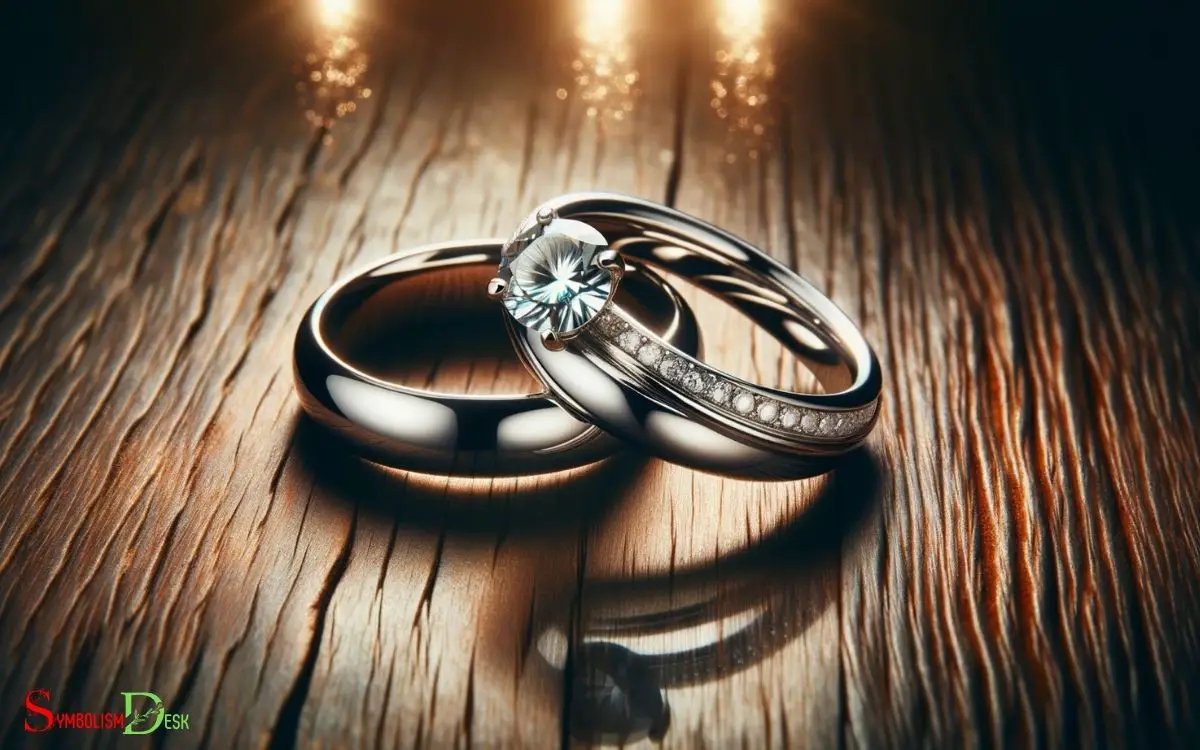What Is the Symbolic Meaning of Wedding Rings? Commitment!
The symbolic meaning of wedding rings encompasses the representation of endless love, commitment, and the joining of two lives in the union of marriage.
As an emblem of fidelity and a physical reminder of a couple’s vows, wedding rings serve as a testament to the enduring partnership and mutual support that marriage signifies.
Wedding rings symbolize:
- Eternal Love: The unending circle of a wedding ring is a symbol of infinite, undying love between partners.
- Commitment: Wearing a wedding ring shows a public pledge to honor the marital commitment.
- Unity: Rings represent the coming together of two individuals to form a harmonious and lifelong bond.
For example, in many Western cultures, the exchange of rings during the wedding ceremony is a central moment, highlighting the importance of these symbols.
Wedding rings are not mere adornments; they are rich with meaning, representing a couple’s everlasting love and dedication to each other.

Key Takeaway
Historical Origins of Wedding Rings
The historical origins of wedding rings date back to ancient civilizations, where the circular shape symbolized eternity and the unbroken bond of marriage.
In ancient Egypt, couples exchanged rings made from braided reeds or hemp, while in ancient Rome, the use of durable iron signified strength and permanence.
Over time, the significance of the wedding ring evolved, with the addition of gemstones in the 15th century symbolizing love and commitment.
The tradition of wearing the ring on the fourth finger of the left hand also has historical roots, as it was believed that a vein from that finger led directly to the heart.
These historical origins provide a rich understanding of the symbolic meaning behind wedding rings, reflecting the enduring nature of love and marriage across different cultures and time periods.
Cultural Significance Across Different Societies
Different societies around the world have unique traditions and symbolism associated with wedding rings.
From the exchange of rings during marriage ceremonies to the significance of specific ring designs, global wedding ring customs offer a diverse tapestry of cultural meanings.
Exploring these traditions can provide valuable insights into the symbolic importance of wedding rings across different societies.
Global Wedding Ring Traditions
Across various societies, exchanging wedding rings symbolizes the union of two individuals and their commitment to each other.
However, the customs and traditions surrounding wedding rings vary widely around the world. In Western cultures, the exchange of rings during a wedding ceremony is a common practice, symbolizing the eternal bond between spouses.
In some Eastern cultures, such as in India, toe rings are exchanged as a symbol of marriage. In Irish culture, the Claddagh ring represents love, loyalty, and friendship.
In South Africa, couples traditionally wear rings on their right hand before marriage and then switch to the left hand after getting married.
These diverse traditions reflect the unique cultural significance of wedding rings worldwide, each with its own beautiful symbolism.
Moving on to the next section, let’s delve into the symbolism in diverse cultures…
Symbolism in Diverse Cultures
Exchanging wedding rings holds diverse symbolic meanings across various cultures, reflecting the unique values and traditions of different societies.
In many cultures, the wedding ring symbolizes eternal love and commitment, but the specific customs and interpretations can differ significantly.
Below is a table highlighting the cultural significance of wedding rings in different societies:
| Culture | Symbolic Meaning |
|---|---|
| Western | Eternal love and commitment |
| Indian | A bond between two souls that transcends time and space |
| Chinese | Endless love and harmony |
| Native American | Unity and an unbreakable bond between the couple |
This table showcases how the symbolism of wedding rings varies across cultures, reflecting the rich tapestry of traditions and beliefs worldwide.
Symbolism of the Circular Shape
The circular shape of wedding rings holds deep symbolic meaning. It represents eternal love and commitment, as there’s no beginning or end to the circle, signifying an everlasting bond.
Additionally, the circular shape also symbolizes unity and wholeness, emphasizing the idea of two individuals coming together as one.
Eternal Love and Commitment
The circular shape of wedding rings symbolizes eternal love and commitment. The unbroken circle represents the timeless nature of love and the commitment to an enduring partnership.
The absence of corners or edges signifies the absence of a beginning or end, emphasizing the eternal nature of the bond between two individuals. This symbolism is powerful, as it conveys the idea of a love that has no boundaries and endures through all circumstances.
The circular shape also represents the cyclical nature of life and the unending commitment to each other. It serves as a constant reminder of the enduring vows made on the wedding day.
This timeless symbolism has made the circular wedding ring a universal symbol of eternal love and commitment across cultures and traditions.
Unity and Wholeness
Representing the unity and wholeness of a couple’s bond, the circular shape of wedding rings serves as a powerful symbol of their enduring commitment.
The unbroken circle signifies the eternal nature of love and the unending commitment between two individuals. The absence of a beginning or end in a ring’s circular shape symbolizes the timeless nature of the couple’s union.
It represents the idea of completeness and unity, where two individuals come together to form a single, unbreakable entity.
The continuous loop of the ring also reflects the ongoing nature of the relationship, with no seams or divisions, signifying the unbroken and seamless journey that the couple embarks on together.
The circular shape of wedding rings encapsulates the concept of unity, wholeness, and the everlasting nature of the couple’s bond.
Endless Bond and Connection
The circular shape of wedding rings symbolizes an endless bond and connection between two individuals.
This symbolism reflects the idea of eternity and the unbroken nature of love and commitment. The circular shape represents a continual and never-ending cycle, signifying the enduring nature of the relationship.
The unbroken circle also signifies the seamless and unending connection between the couple, highlighting their unity and commitment to each other.
- Eternal love and commitment
- Unbroken connection and unity
- Continual and never-ending cycle
Representing Eternal Love and Commitment
Wedding rings symbolize eternal love and commitment between two individuals. The circular shape of the ring represents unending love, with no beginning or end. It serves as a constant reminder of the vows exchanged and the promise of everlasting devotion.
By wearing the ring, couples signify their dedication to each other, regardless of the challenges they may face. The unbroken circle also symbolizes the unbreakable bond between partners, reflecting their enduring commitment to one another.
This representation of eternal love and commitment through wedding rings has been honored for centuries and continues to hold significant meaning in modern-day marriages. It serves as a visible and tangible symbol of the enduring unity and devotion shared between spouses.
Uniting Two Individuals in Marriage
When two individuals exchange wedding rings, they symbolize the union of their lives in marriage, solidifying their commitment and love for each other. This act of exchanging rings represents the coming together of two individuals to form a new entity as a married couple.
- Shared Journey: The wedding rings signify the beginning of a shared journey, where both individuals navigate through life together, facing its joys and challenges as one.
- Commitment: The exchange of wedding rings is a public declaration of the commitment each individual has made to the other, promising to support and love each other through thick and thin.
- Unity: The rings serve as a visible symbol of the unity between the two individuals, reminding them of their bond and the promises they’ve made to each other.
Traditions and Rituals Associated With Wedding Rings
Exchanging wedding rings involves incorporating age-old customs and rituals that encapsulate the significance of the union.
The tradition of wearing wedding rings dates back to ancient Egypt, where the circle symbolized eternity and the open center represented a gateway to the unknown future.
In some cultures, the exchange of rings is accompanied by specific rituals, such as the sharing of a cup of wine or the binding of the couple’s hands with a ribbon. Another common ritual is the passing of the rings among the wedding guests for blessings and well-wishes.
Additionally, the act of placing the ring on the fourth finger of the left hand is steeped in tradition, as it was believed by the Romans to be directly connected to the heart.
These rituals and traditions add depth and meaning to the exchange of wedding rings, symbolizing the enduring commitment and love between the couple.
How can the symbolic meaning of a dog relate to the symbolic meaning of wedding rings in terms of commitment and protection?
The symbolic meaning of dog protection can be closely tied to the symbolic meaning of wedding rings in terms of commitment and protection. Just as dogs are known for their loyalty and protective nature, wedding rings symbolize a commitment to protect and support one another through life’s journey.
Modern Interpretations and Evolving Symbolism
The symbolic meaning of wedding rings has evolved over time, reflecting changing societal values and cultural influences.
In modern times, wedding rings carry various interpretations and evolving symbolism, including:
- Expression of Individuality: Many couples now opt for unique and personalized wedding ring designs, symbolizing their distinct personalities and love story.
- Equality and Partnership: The exchange of rings is often viewed as a symbol of equality and partnership between the spouses, signifying mutual respect and support.
- Commitment Beyond Tradition: Modern interpretations emphasize the emotional and personal significance of wedding rings, representing a deep commitment and enduring love beyond traditional norms.
These evolving symbolisms reflect the contemporary values and beliefs of couples, showcasing the diverse ways in which wedding rings hold meaning in today’s society.
Conclusion
Wedding rings hold deep symbolic meaning across cultures. They represent eternal love, commitment, and the unity of two individuals in marriage. Understanding diamond symbolism adds another layer of significance to wedding rings. Diamonds are the hardest natural substance on Earth, symbolizing the strength and endurance of the marriage bond. Additionally, their brilliant sparkle represents the joy and happiness that comes with finding true love. As a result, the exchange of wedding rings, particularly those adorned with diamonds, is a powerful and emotional tradition that transcends time and culture.
The circular shape of wedding rings symbolizes endless love. The traditions associated with wedding rings continue to evolve, reflecting the changing interpretations and values of marriage in modern society.
The symbolism of wedding rings serves as a powerful reminder of the enduring bond between two people. Therefore, wedding rings are cherished and timeless symbols of love.






